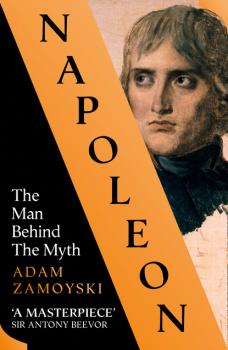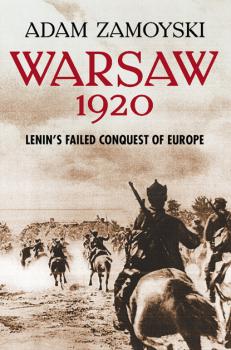Adam Zamoyski
Список книг автора Adam ZamoyskiNapoleon
‘Napoleon is an out-and-out masterpiece and a joy to read’ Sir Antony Beevor, author of StalingradA landmark new biography that presents the man behind the many myths. The first writer in English to go back to the original European sources, Adam Zamoyski’s portrait of Napoleon is historical biography at its finest.Napoleon inspires passionately held and often conflicting visions. Was he a god-like genius, Romantic avatar, megalomaniac monster, compulsive warmonger or just a nasty little dictator?While he displayed elements of these traits at certain times, Napoleon was none of these things. He was a man and, as Adam Zamoyski presents him in this landmark biography, a rather ordinary one at that. He exhibited some extraordinary qualities during some phases of his life but it is hard to credit genius to a general who presided over the worst (and self-inflicted) disaster in military history and who single-handedly destroyed the great enterprise he and others had toiled so hard to construct. A brilliant tactician, he was no strategist.But nor was Napoleon an evil monster. He could be selfish and violent but there is no evidence of him wishing to inflict suffering gratuitously. His motives were mostly praiseworthy and his ambition no greater than that of contemporaries such as Alexander I of Russia, Wellington, Nelson and many more. What made his ambition exceptional was the scope it was accorded by circumstance.Adam Zamoyski strips away the lacquer of prejudice and places Napoleon the man within the context of his times. In the 1790s, a young Napoleon entered a world at war, a bitter struggle for supremacy and survival with leaders motivated by a quest for power and by self-interest. He did not start this war but it dominated his life and continued, with one brief interruption, until his final defeat in 1815.Based on primary sources in many European languages, and beautifully illustrated with portraits done only from life, this magnificent book examines how Napoleone Buonaparte, the boy from Corsica, became ‘Napoleon’; how he achieved what he did, and how it came about that he undid it. It does not justify or condemn but seeks instead to understand Napoleon’s extraordinary trajectory.
1812
Adam Zamoyski’s bestselling account of Napoleon’s invasion of Russia and his catastrophic retreat from Moscow, events that had a profound effect on European history.In 1812 the most powerful man in the world assembled the largest army in history and marched on Moscow with the intention of consolidating his dominion. But within months, Napoleon’s invasion of Russia – history’s first example of total war – had turned into an epic military disaster. Over 400,000 French and Allied troops perished and Napoleon was forced to retreat.Adam Zamoyski’s masterful work draws on the harrowing first-hand accounts of soldiers and civilians on both sides of the conflict. The result takes the reader beyond the invasion of Russia to present both a poignant tale of the individual foot soldier and a sweeping history of a turbulent time.
Warsaw 1920
The dramatic and little-known story of how, in the summer of 1920, Lenin came within a hair's breadth of shattering the painstakingly constructed Versailles peace settlement and spreading Bolshevism to western Europe.In 1920 the new Soviet state was a mess, following a brutal civil war, and the best way of ensuring its survival appeared to be to export the revolution to Germany, itself economically ruined by defeat in World War I and racked by internal political dissension.Between Russia and Germany lay Poland, a nation that had only just recovered its independence after more than a century of foreign oppression. But it was economically and militarily weak and its misguided offensive to liberate the Ukraine in the spring of 1920 laid it open to attack. Egged on by Trotsky, Lenin launched a massive westward advance under the flamboyant Marshal Tukhachevsky.All that Great Britain and France had fought for over four years now seemed at risk. By the middle of August the Russians were only a few kilometres from Warsaw, and Berlin was less than a week's march away. Then occurred the 'Miracle of the Vistula': the Polish army led by Jozef Pilsudski regrouped and achieved one of the most decisive victories in military history.As a result, the Versailles peace settlement survived, and Lenin was forced to settle for Communism in one country. The battle for Warsaw bought Europe nearly two decades of peace, and communism remained a mainly Russian phenomenon, subsuming many of the autocratic and Byzantine characteristics of Russia's tsarist tradition.
Warsaw 1920: Lenin’s Failed Conquest of Europe
The dramatic and little-known story of how, in the summer of 1920, Lenin came within a hair's breadth of shattering the painstakingly constructed Versailles peace settlement and spreading Bolshevism to western Europe.In 1920 the new Soviet state was a mess, following a brutal civil war, and the best way of ensuring its survival appeared to be to export the revolution to Germany, itself economically ruined by defeat in World War I and racked by internal political dissension.Between Russia and Germany lay Poland, a nation that had only just recovered its independence after more than a century of foreign oppression. But it was economically and militarily weak and its misguided offensive to liberate the Ukraine in the spring of 1920 laid it open to attack. Egged on by Trotsky, Lenin launched a massive westward advance under the flamboyant Marshal Tukhachevsky.All that Great Britain and France had fought for over four years now seemed at risk. By the middle of August the Russians were only a few kilometres from Warsaw, and Berlin was less than a week's march away. Then occurred the 'Miracle of the Vistula': the Polish army led by Jozef Pilsudski regrouped and achieved one of the most decisive victories in military history.As a result, the Versailles peace settlement survived, and Lenin was forced to settle for Communism in one country. The battle for Warsaw bought Europe nearly two decades of peace, and communism remained a mainly Russian phenomenon, subsuming many of the autocratic and Byzantine characteristics of Russia's tsarist tradition.
Napoleon: The Man Behind the Myth
‘Napoleon is an out-and-out masterpiece and a joy to read’ Sir Antony Beevor, author of StalingradA landmark new biography that presents the man behind the many myths. The first writer in English to go back to the original European sources, Adam Zamoyski’s portrait of Napoleon is historical biography at its finest.Napoleon inspires passionately held and often conflicting visions. Was he a god-like genius, Romantic avatar, megalomaniac monster, compulsive warmonger or just a nasty little dictator?While he displayed elements of these traits at certain times, Napoleon was none of these things. He was a man and, as Adam Zamoyski presents him in this landmark biography, a rather ordinary one at that. He exhibited some extraordinary qualities during some phases of his life but it is hard to credit genius to a general who presided over the worst (and self-inflicted) disaster in military history and who single-handedly destroyed the great enterprise he and others had toiled so hard to construct. A brilliant tactician, he was no strategist.But nor was Napoleon an evil monster. He could be selfish and violent but there is no evidence of him wishing to inflict suffering gratuitously. His motives were mostly praiseworthy and his ambition no greater than that of contemporaries such as Alexander I of Russia, Wellington, Nelson and many more. What made his ambition exceptional was the scope it was accorded by circumstance.Adam Zamoyski strips away the lacquer of prejudice and places Napoleon the man within the context of his times. In the 1790s, a young Napoleon entered a world at war, a bitter struggle for supremacy and survival with leaders motivated by a quest for power and by self-interest. He did not start this war but it dominated his life and continued, with one brief interruption, until his final defeat in 1815.Based on primary sources in many European languages, and beautifully illustrated with portraits done only from life, this magnificent book examines how Napoleone Buonaparte, the boy from Corsica, became ‘Napoleon’; how he achieved what he did, and how it came about that he undid it. It does not justify or condemn but seeks instead to understand Napoleon’s extraordinary trajectory.
Poland: A history
A substantially revised and updated edition of the author's classic 1987 book, 'The Polish Way: A Thousand-Year History of the Poles and their Culture', which has been out of print since 2001.No nation's history has been so distorted as that of Poland. In 1797 Russia, Prussia and Austria divided the country up among themselves, expunging Poland’s sovereignty from history, casting it as a backwater that needed civilising. But as Adam Zamoyski’s thrilling history shows, the country they had wiped off the map had been one of Europe’s largest and most varied in cultural and religious traditions, with one of the boldest constitutional experiments ever attempted. Its destruction initiated a series of struggles that culminated in the two world wars and the Cold War. Today, Poland has been restored to its rightful place as one of the most vigorous nations of Europe, and is perfectly captured in this full revision Adam Zamoyski's classic ‘The Polish Way’.
Phantom Terror: The Threat of Revolution and the Repression of Liberty 1789-1848
A magnificent and timely examination of an age of fear, subversion, suppression and espionage, Adam Zamoyski explores the attempts of the governments of Europe to police the world in a struggle against obscure forces, seemingly dedicated to the overthrow of civilisation.The French Revolution and the blood-curdling violence it engendered terrified the ruling and propertied classes of Europe. Unable to grasp how such horrors could have come about, many concluded that it was the result of a devilish conspiracy hatched by Freemasons inspired by the ideas of the Enlightenment with the aim of overthrowing the entire social order, along with the legal and religious principles it stood on. Others traced it back to the Reformation or the Knights Templar and ascribed even more sinister aims to it.Faced by this apparently occult threat, they resorted to repression on an unprecedented scale, expanding police and spy networks in the process. Napoleon managed to contain the revolutionary elements in France and those parts of Europe he controlled, but while many welcomed this, others saw in him no more than the spawn of the Revolution, propagating its doctrines by other means. After his defeat at Waterloo in 1815, his victors united to maintain the old order, suppress of all opposition, and ferret out of the conspirators whom they believed to be plotting mayhem and murder in the shadows.In this ground-breaking study best-selling historian Adam Zamoyski exposes their pusillanimous yet cynical recourse to the police spy and the bayonet, which only intensified their own fears and pushed ordinary people towards subversion, building up the pressure of opposition to their rule.When it came, with the revolutions of 1848, the dreaded cataclysm revealed their fears to have been groundless; the masses stirred into revolt by hunger and oppressive living conditions were leaderless and easily pacified. There never had been any conspiracy. But the police were there to stay, and the paradigm of an order threatened by dark forces is also still with us today. This compelling history, occasionally chilling and often hilarious, tells how the modern state evolved through the expansion of its organs of control, and holds urgent lessons for today.









